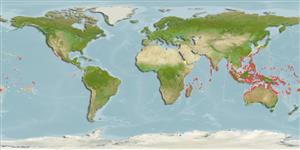Gastropoda |
Littorinimorpha |
Cassidae
Environment: milieu / climate zone / Mức độ sâu / distribution range
Sinh thái học
; Mức độ sâu 0 - 12 m (Tài liệu tham khảo 349). Tropical
Indo-Pacific: from East Africa, including Madagascar, Sri Lanka and the tropical islands of the Indian Ocean, through Indonesia and Melanesia, to eastern Polynesia; north to Taiwan Province of China and southern Japan, and south to northern Queensland and the Fiji Islands.
Length at first maturity / Bộ gần gũi / Weight / Age
Chín muồi sinh dục: Lm ? range ? - ? cm Max length : 18.0 cm SHL con đực/không giới tính; (Tài liệu tham khảo 349); common length : 15.0 cm SHL con đực/không giới tính; (Tài liệu tham khảo 349)
Shell well known as the main raw material from which cameos are cut. Species abundant only at the extreme western and eastern parts of its wide range, becoming rarer in its central part, corresponding with the Southeast Asian region (Ref. 349). Most common in fairly sheltered areas, on bottoms of coarse coral sand. Shallow subtidal waters. Preys on short-spined sea urchins (Ref. 349).
Life cycle and mating behavior
Chín muồi sinh dục | Sự tái sinh sản | Đẻ trứng | Eggs | Sự sinh sản | Larvae
Members of the order Neotaenioglossa are mostly gonochoric and broadcast spawners. Life cycle: Embryos develop into planktonic trocophore larvae and later into juvenile veligers before becoming fully grown adults.
Poutiers, J.M. 1998 Gastropods. p. 363-648. In Carpenter, K. E. and V. H. Niem. 1998. FAO species identification guide for fishery purposes. The living marine resources of the Western Central Pacific. Volume 1. Seaweeds, corals, bivalves, and gastropods. Rome, FAO. (Tài liệu tham khảo 349)
IUCN Red List Status
(Tài liệu tham khảo 130435: Version 2025-1)
CITES status (Tài liệu tham khảo 108899)
Not Evaluated
CMS (Tài liệu tham khảo 116361)
Not Evaluated
Threat to humans
Harmless
Human uses
| FishSource |
Các công cụ
Thêm thông tin
Sinh thái dinh dưỡngFood items (preys)
Thành phần thức ăn
Thành phần thức ăn
Các động vật ăn mồi
Population dynamicsSự sinh trưởngMax. ages / sizesLength-weight rel.Length-length rel.Length-frequenciesMass conversionSự phong phú Life cycleSự tái sinh sảnChín muồi sinh dụcSự sinh sảnĐẻ trứngEggsEgg developmentLarvae PhysiologyThành phần ô-xy
Các nguồn internet
Estimates based on models
Preferred temperature
(Ref.
115969): 24.7 - 29.3, mean 28.4 (based on 2621 cells).
Fishing Vulnerability
Low vulnerability (10 of 100).
Price category
Unknown.
